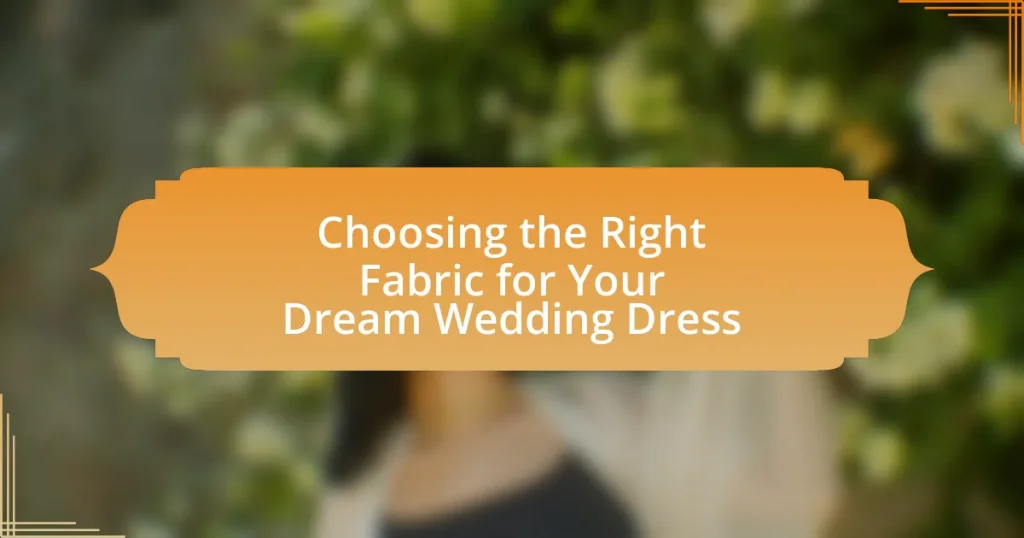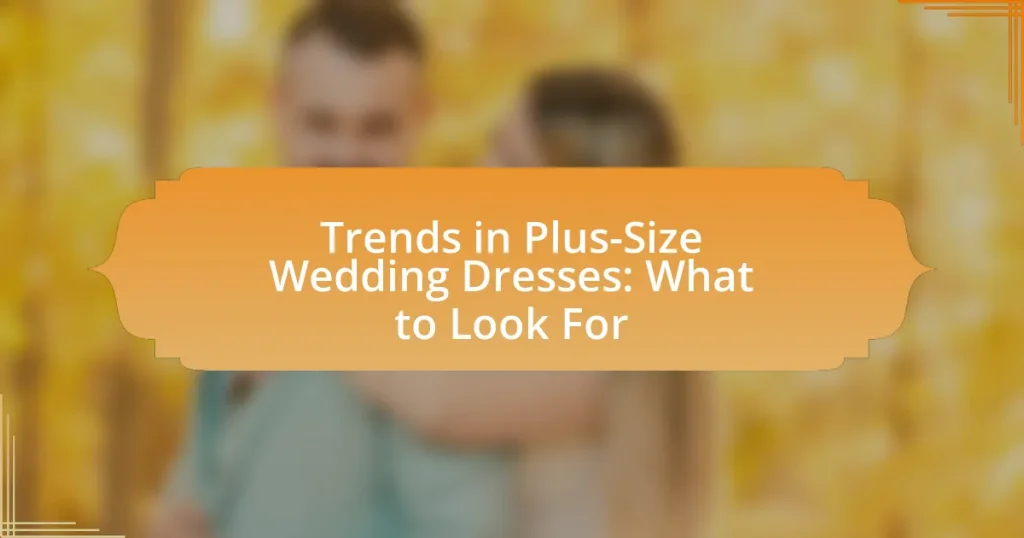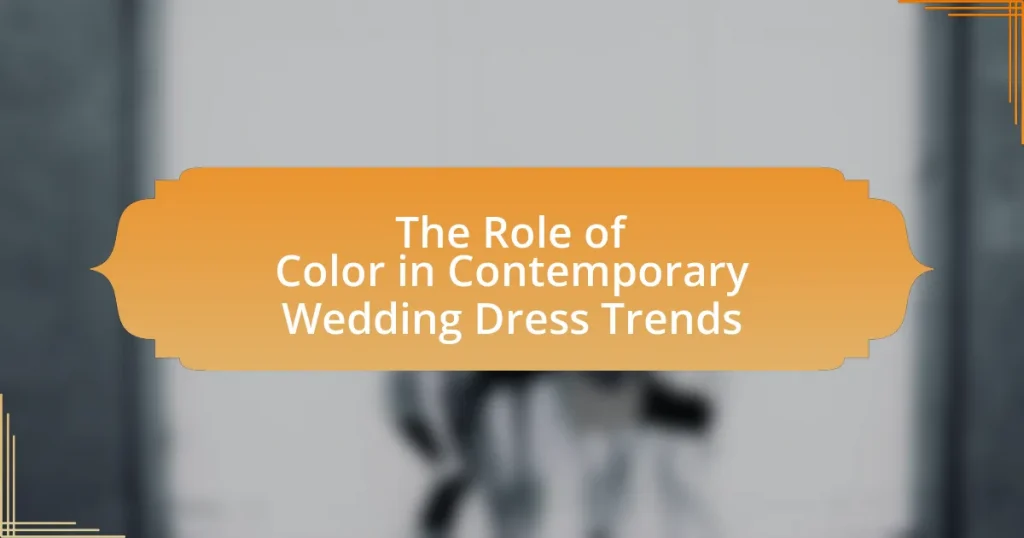Choosing the right fabric for your dream wedding dress is essential for achieving both aesthetic appeal and comfort. Key factors to consider include the fabric’s comfort, drape, and suitability for the wedding season. The article explores how different silhouettes influence fabric choice, highlighting popular styles such as A-line, ball gown, mermaid, and sheath, and their corresponding fabric requirements. It also discusses the impact of personal style and wedding themes on fabric selection, along with common fabric types like satin, lace, chiffon, and tulle, detailing their characteristics and advantages. Additionally, practical tips for working with designers and making informed fabric decisions are provided to ensure a successful choice for the wedding day.
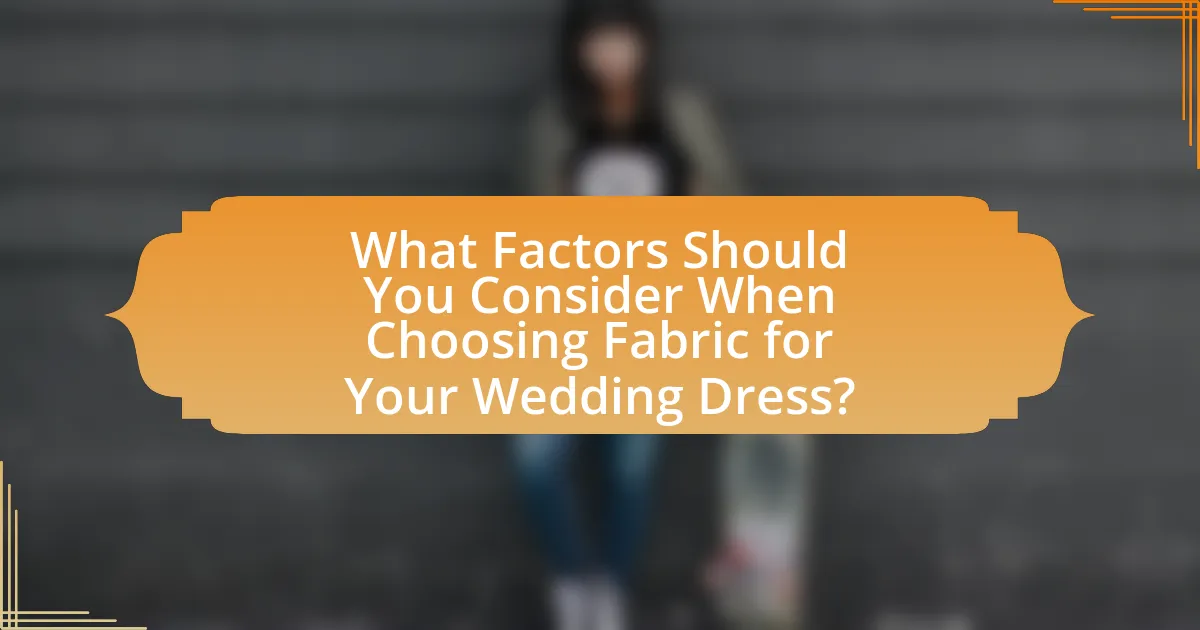
What Factors Should You Consider When Choosing Fabric for Your Wedding Dress?
When choosing fabric for your wedding dress, consider factors such as comfort, drape, and the season. Comfort is crucial because you will wear the dress for an extended period; fabrics like silk or chiffon are breathable and soft against the skin. Drape affects how the dress falls and moves; heavier fabrics like satin create structure, while lighter fabrics like tulle offer a more ethereal look. The season also influences fabric choice; for summer weddings, lightweight materials are preferable, while heavier fabrics may be suitable for winter. These considerations ensure that the fabric aligns with your vision and practical needs for the wedding day.
How does the wedding dress silhouette influence fabric choice?
The wedding dress silhouette significantly influences fabric choice by determining the drape, structure, and overall aesthetic of the gown. For example, a fitted silhouette, such as a mermaid or trumpet style, typically requires fabrics with more structure, like satin or taffeta, to maintain the shape and support the body contours. In contrast, flowing silhouettes like A-line or sheath dresses often utilize lighter, more fluid fabrics such as chiffon or organza, which enhance movement and create a soft, romantic look. This relationship between silhouette and fabric is crucial, as the right fabric not only complements the design but also affects comfort and wearability throughout the wedding day.
What silhouettes are popular for wedding dresses?
A-line, ball gown, mermaid, and sheath are popular silhouettes for wedding dresses. The A-line silhouette features a fitted bodice that gradually flares out from the waist, making it flattering for various body types. Ball gowns are characterized by a full skirt and fitted bodice, often chosen for formal weddings. The mermaid silhouette hugs the body and flares out at the knees, emphasizing curves, while the sheath silhouette is form-fitting and runs straight down from the neckline to the hem. These silhouettes are favored for their ability to enhance different body shapes and styles, making them timeless choices in bridal fashion.
How do different silhouettes affect fabric draping and movement?
Different silhouettes significantly influence fabric draping and movement by altering how the material interacts with the body’s shape and motion. For instance, an A-line silhouette allows fabric to flow freely from the waist, creating a gentle drape that enhances movement, while a fitted silhouette restricts fabric flow, resulting in a more structured appearance that can limit mobility. Additionally, fabrics with more weight, like satin, will drape differently compared to lighter materials, such as chiffon, which will flutter and move more dynamically in flowing silhouettes. This relationship between silhouette and fabric type is crucial in achieving the desired aesthetic and comfort in wedding dress design.
What role does the wedding season play in fabric selection?
The wedding season significantly influences fabric selection by dictating the types of materials that are in demand based on seasonal weather and trends. During warmer months, lightweight fabrics such as chiffon, organza, and lace are preferred for their breathability and comfort, while cooler months often see a preference for heavier materials like satin, taffeta, and velvet that provide warmth. This seasonal variation is supported by industry trends, where bridal designers often release collections aligned with seasonal themes, ensuring that the fabrics chosen not only suit the climate but also reflect current fashion aesthetics.
Which fabrics are suitable for summer weddings?
Lightweight and breathable fabrics are suitable for summer weddings. Fabrics such as chiffon, linen, cotton, and organza are ideal choices due to their ability to keep the wearer cool and comfortable in warm weather. Chiffon is known for its airy quality and flowy drape, making it a popular option for summer dresses. Linen is highly breathable and has a natural texture that adds elegance while allowing for airflow. Cotton is soft and lightweight, providing comfort and ease of movement. Organza, a thin and crisp fabric, adds structure without adding weight, making it perfect for summer styles. These fabrics not only enhance comfort but also contribute to a light and romantic aesthetic, which is often desired for summer weddings.
What are the best fabric choices for winter weddings?
The best fabric choices for winter weddings include velvet, satin, and brocade. Velvet provides warmth and a luxurious texture, making it ideal for colder temperatures. Satin offers a smooth finish and a slight sheen, which can enhance the elegance of winter attire. Brocade, with its intricate patterns and heavier weight, adds a regal touch suitable for winter celebrations. These fabrics not only provide comfort against the cold but also contribute to the overall aesthetic of a winter wedding.
How do personal style and wedding theme impact fabric choice?
Personal style and wedding theme significantly influence fabric choice for wedding dresses. Personal style reflects individual preferences, such as romantic, modern, or bohemian aesthetics, which dictate fabric selection; for instance, a romantic style may favor soft, flowing fabrics like chiffon or lace, while a modern style might lean towards structured materials like satin or taffeta. The wedding theme also plays a crucial role; a rustic theme may call for natural fabrics like cotton or linen, while a formal theme typically requires luxurious fabrics such as silk or organza. This alignment between personal style, wedding theme, and fabric choice ensures that the dress complements the overall vision of the wedding, creating a cohesive and harmonious look.
What fabrics align with classic wedding themes?
Silk, satin, lace, and tulle are fabrics that align with classic wedding themes. Silk offers a luxurious feel and elegant drape, making it a popular choice for traditional gowns. Satin, known for its smooth surface and sheen, enhances the formal look of wedding attire. Lace adds intricate detailing and a romantic touch, often used in overlays or accents. Tulle, a lightweight and airy fabric, is frequently utilized for veils and skirts, contributing to a whimsical aesthetic. These fabrics have been historically favored in wedding fashion, reflecting timeless elegance and sophistication.
How can modern trends influence fabric selection?
Modern trends significantly influence fabric selection by prioritizing sustainability, versatility, and innovative textures. For instance, the rise of eco-conscious consumerism has led designers to choose organic cotton, recycled polyester, and other sustainable materials, reflecting a commitment to environmental responsibility. Additionally, trends such as minimalism and bohemian styles have popularized lightweight fabrics like chiffon and lace, which offer both elegance and comfort. The increasing demand for personalization has also encouraged the use of unique blends and custom prints, allowing brides to express their individuality. These trends are supported by market research indicating that 70% of consumers prefer brands that are environmentally friendly, showcasing the impact of modern values on fabric choices.
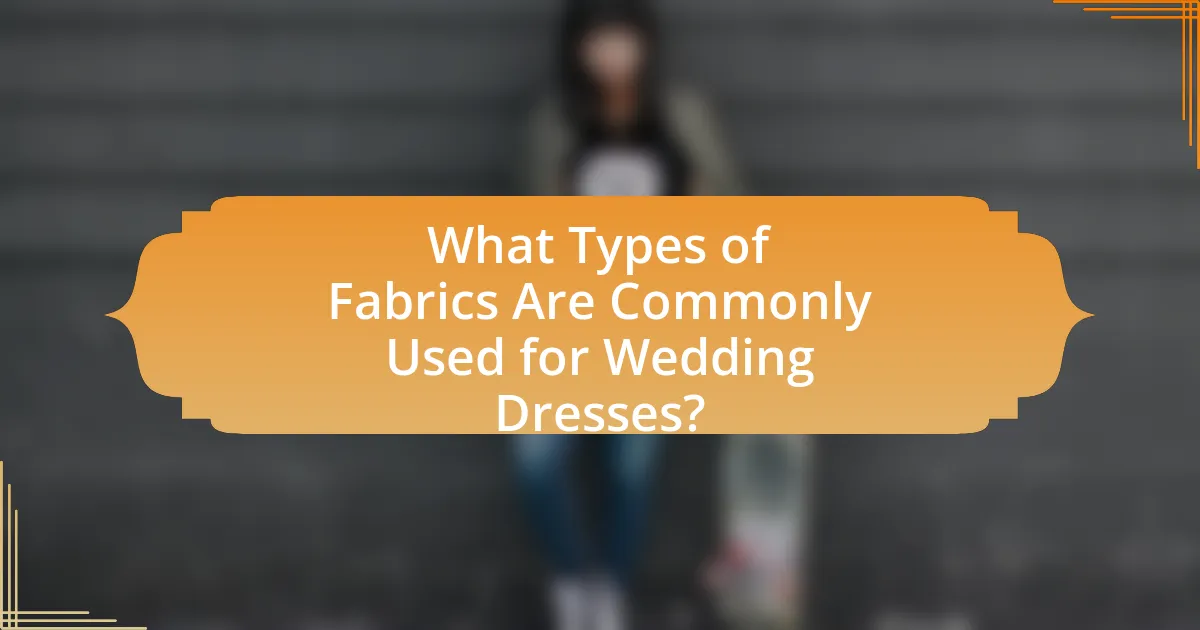
What Types of Fabrics Are Commonly Used for Wedding Dresses?
Commonly used fabrics for wedding dresses include satin, lace, chiffon, tulle, and organza. Satin is favored for its luxurious feel and smooth finish, making it a popular choice for formal gowns. Lace adds intricate detailing and texture, often used for overlays or accents. Chiffon is lightweight and flowy, ideal for creating ethereal silhouettes. Tulle, known for its stiffness and volume, is often used in skirts and veils. Organza, similar to tulle but crisper, provides structure and elegance. These fabrics are chosen based on their aesthetic qualities and how they complement the overall design of the wedding dress.
What are the characteristics of popular wedding dress fabrics?
Popular wedding dress fabrics include satin, lace, tulle, chiffon, and organza, each with distinct characteristics. Satin is known for its luxurious sheen and smooth texture, providing a structured silhouette. Lace features intricate patterns and a delicate appearance, often used for overlays or accents, adding a romantic touch. Tulle is lightweight and airy, ideal for creating volume in skirts and veils. Chiffon is soft and flowy, offering a graceful drape that enhances movement. Organza is crisp and sheer, often used for layering and creating a structured look. These fabrics are chosen based on their aesthetic appeal, comfort, and how they complement the overall design of the wedding dress.
What makes satin a favored choice for wedding dresses?
Satin is a favored choice for wedding dresses due to its luxurious appearance and smooth texture. The fabric has a natural sheen that enhances the elegance of bridal gowns, making it visually appealing in photographs and during ceremonies. Additionally, satin drapes beautifully, allowing for flattering silhouettes that can accentuate the bride’s figure. Its weight provides structure while still being comfortable to wear, which is essential for long wedding days. Furthermore, satin is versatile, available in various weights and finishes, catering to different styles and preferences.
How does lace add elegance to wedding gowns?
Lace adds elegance to wedding gowns by introducing intricate patterns and textures that enhance the overall aesthetic. The delicate nature of lace creates a romantic and sophisticated appearance, often associated with traditional bridal wear. Historically, lace has been used in high-fashion garments since the 16th century, symbolizing luxury and refinement. Its ability to layer beautifully over other fabrics allows for a unique interplay of light and shadow, further elevating the gown’s elegance.
What are the pros and cons of using different fabrics?
Different fabrics offer unique advantages and disadvantages for wedding dresses. For instance, silk is luxurious and drapes beautifully, but it can be expensive and requires careful maintenance. Cotton is breathable and comfortable, making it ideal for warm weather, yet it may lack the elegance of more formal fabrics. Lace adds intricate detail and texture, enhancing visual appeal, but it can be delicate and may require special care. Polyester is affordable and durable, but it may not provide the same level of breathability or comfort as natural fibers. Each fabric choice impacts the overall look, feel, and practicality of the wedding dress, influencing the decision based on personal preferences and wedding conditions.
What are the advantages of using tulle in wedding dresses?
Tulle offers several advantages for wedding dresses, primarily its lightweight nature, which provides a delicate and ethereal appearance. This fabric allows for intricate layering, creating volume without excessive weight, making it comfortable for long wear. Additionally, tulle is versatile, easily manipulated into various styles, from ball gowns to A-line silhouettes, enhancing the overall design. Its sheer quality adds a romantic touch, allowing for creative layering with other fabrics, such as satin or lace, to achieve a unique look. Tulle is also relatively affordable compared to other fabrics, making it a popular choice for brides on a budget.
What challenges might arise when using chiffon?
Chiffon presents several challenges when used in wedding dress design. Firstly, chiffon is a lightweight and sheer fabric, making it prone to fraying and requiring careful handling during cutting and sewing. Additionally, its delicate nature can lead to difficulties in achieving structured designs, as chiffon lacks the stiffness needed for certain silhouettes. Furthermore, chiffon can be challenging to layer without adding bulk, complicating the design process. Lastly, the fabric’s tendency to slip can result in misalignment during construction, necessitating extra precautions to ensure accuracy. These factors highlight the complexities involved in working with chiffon for wedding dresses.
How do fabric textures affect the overall look of a wedding dress?
Fabric textures significantly influence the overall look of a wedding dress by affecting its drape, silhouette, and visual appeal. For instance, a smooth satin creates a sleek and elegant appearance, while a textured lace adds depth and romantic detail. The choice of fabric texture can also impact how light interacts with the dress; for example, silk reflects light beautifully, enhancing the gown’s luxurious feel, whereas matte fabrics may offer a more understated elegance. Additionally, the tactile quality of the fabric can evoke different emotions and styles, with heavier fabrics like taffeta providing structure and formality, while lighter fabrics like chiffon lend a soft, ethereal quality. Thus, the selection of fabric texture is crucial in achieving the desired aesthetic and emotional impact of a wedding dress.
What textures are trending in wedding dress fabrics?
Textured fabrics such as lace, tulle, and satin are currently trending in wedding dress designs. Lace offers intricate patterns and a romantic feel, while tulle provides a light, airy quality that enhances volume. Satin, known for its smooth finish and luxurious appearance, remains a classic choice. These textures not only add visual interest but also cater to various bridal aesthetics, from traditional to modern. The popularity of these fabrics is supported by recent bridal fashion shows, where designers prominently featured them in their collections, reflecting current consumer preferences for elegance and sophistication in wedding attire.
How can texture enhance or detract from a wedding dress design?
Texture can significantly enhance or detract from a wedding dress design by influencing its visual appeal and tactile experience. For instance, intricate lace or embroidered textures can add depth and elegance, creating a romantic and sophisticated look. Conversely, overly heavy or coarse textures may overwhelm the design, making it appear bulky or unflattering. Research indicates that the choice of fabric texture can affect the perception of fit and silhouette, with softer textures often providing a more flattering drape. Thus, selecting the right texture is crucial for achieving the desired aesthetic and comfort in a wedding dress.
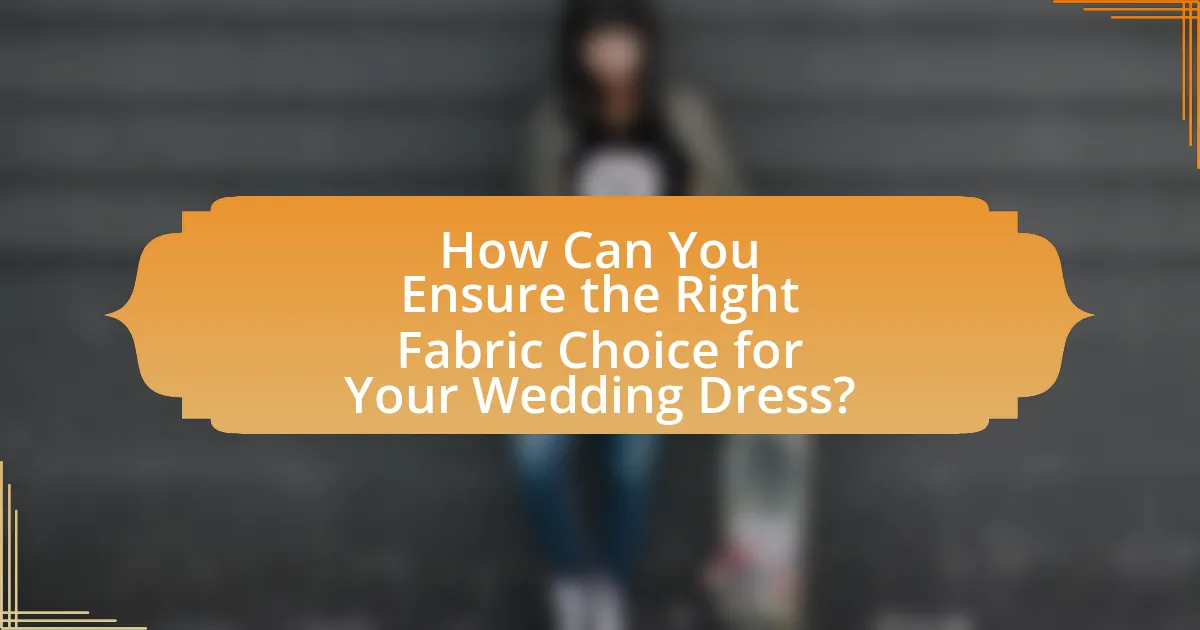
How Can You Ensure the Right Fabric Choice for Your Wedding Dress?
To ensure the right fabric choice for your wedding dress, assess the fabric’s drape, weight, and texture in relation to your dress design and wedding season. Fabrics like satin and silk provide a luxurious feel and work well for formal weddings, while lighter materials such as chiffon or lace are suitable for warmer climates. Additionally, consider the fabric’s breathability and comfort, as you will be wearing the dress for an extended period. Research indicates that the right fabric can enhance the overall aesthetic and comfort of the dress, making it essential to test samples against your skin and in different lighting conditions to see how they react.
What should you consider when trying on wedding dress fabrics?
When trying on wedding dress fabrics, you should consider the fabric’s texture, weight, and drape. The texture affects comfort and how the fabric feels against the skin, while the weight influences how the dress hangs and moves. Drape determines how the fabric flows and shapes the silhouette of the dress. For example, heavier fabrics like satin provide structure, while lighter fabrics like chiffon create a more ethereal look. Understanding these characteristics helps in selecting a fabric that aligns with your vision for the wedding dress.
How does comfort play a role in fabric selection?
Comfort is a critical factor in fabric selection for wedding dresses, as it directly affects the wearer’s experience throughout the event. Fabrics that are soft, breathable, and flexible enhance comfort, allowing the bride to move freely and enjoy her day without discomfort. For instance, natural fibers like cotton and silk are known for their breathability and softness, making them popular choices for wedding dresses. Studies indicate that comfort in clothing can significantly influence a person’s confidence and overall satisfaction, which is particularly important on a day as significant as a wedding. Therefore, selecting fabrics that prioritize comfort ensures that the bride feels at ease and can fully engage in her celebration.
What should you look for in terms of fabric quality?
When assessing fabric quality for a wedding dress, look for durability, texture, and breathability. High-quality fabrics, such as silk, satin, and chiffon, offer a luxurious feel and maintain their shape over time. Durability ensures the fabric withstands wear, while texture affects comfort against the skin. Breathability is crucial for comfort, especially in varying temperatures. For instance, silk is known for its strength and smoothness, making it a popular choice for wedding dresses.
How can you work with a designer to choose the right fabric?
To work with a designer to choose the right fabric, communicate your vision and preferences clearly. This involves discussing the style, drape, and texture you desire for your wedding dress. Designers often have extensive knowledge of fabric types and their properties, which can guide you in selecting materials that align with your aesthetic and functional needs. For instance, silk offers a luxurious feel, while lace adds intricate detail. Engaging in this dialogue allows the designer to recommend fabrics that not only match your vision but also suit the dress’s structure and comfort.
What questions should you ask your designer about fabric options?
You should ask your designer about the durability, breathability, and drape of the fabric options. Understanding the durability ensures the fabric can withstand wear throughout the event, while breathability is crucial for comfort, especially in varying temperatures. The drape affects how the fabric falls and shapes the overall silhouette of the wedding dress. Additionally, inquire about the fabric’s care requirements, as some materials may need special handling or cleaning. These questions help ensure that the chosen fabric aligns with your vision and practical needs for the wedding day.
How can a designer help you visualize fabric choices?
A designer can help you visualize fabric choices by providing physical samples and digital renderings of the fabrics. By presenting swatches, the designer allows you to see and feel the texture, weight, and color of each fabric, which aids in making informed decisions. Additionally, designers often use software to create visualizations of how different fabrics will look when draped or tailored into a wedding dress, enhancing your understanding of the final product. This approach is supported by industry practices where tactile and visual aids are essential in the fabric selection process, ensuring that clients can make choices that align with their vision for their wedding dress.
What are some tips for making the final fabric decision?
To make the final fabric decision for a wedding dress, prioritize the fabric’s drape, texture, and comfort. Selecting a fabric that complements the dress design is crucial; for instance, silk offers elegance and flow, while lace adds texture and romance. Additionally, consider the season and venue, as heavier fabrics may be unsuitable for a summer wedding. Testing fabric swatches against skin tone and ensuring breathability can enhance comfort. Research indicates that the right fabric choice significantly impacts the overall aesthetic and wearability of the dress, making it essential to evaluate options thoroughly before finalizing.
How can you balance personal preference with practical considerations?
To balance personal preference with practical considerations when choosing fabric for a wedding dress, prioritize the desired aesthetic while evaluating the fabric’s functionality. For instance, if a bride prefers a flowing silhouette, she might choose chiffon, which offers elegance and movement, but must also consider its durability and how it drapes in various weather conditions. Research indicates that 70% of brides prioritize comfort alongside style, highlighting the importance of selecting fabrics that not only look good but also feel good throughout the event. Thus, aligning personal taste with practical aspects like comfort, breathability, and maintenance ensures a satisfying choice for the wedding dress.
What common mistakes should you avoid when choosing fabric?
When choosing fabric for a wedding dress, common mistakes to avoid include selecting materials solely based on appearance without considering comfort, neglecting the fabric’s weight and drape, and failing to account for the season and venue. Choosing a fabric that looks beautiful but is uncomfortable can lead to a negative experience on the wedding day. For instance, heavier fabrics may be unsuitable for a summer wedding, while lighter fabrics may not provide enough warmth for a winter event. Additionally, ignoring the fabric’s drape can result in a dress that does not fit or flow as intended, impacting the overall look. Therefore, it is crucial to balance aesthetics with practicality to ensure a successful fabric choice.
